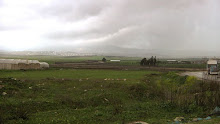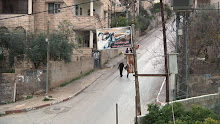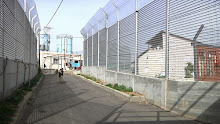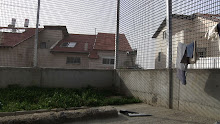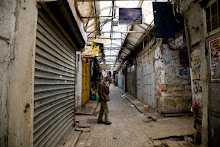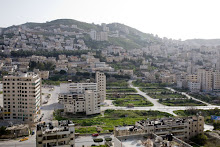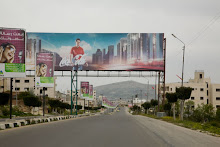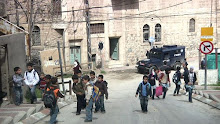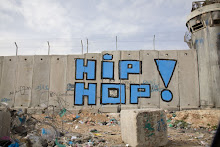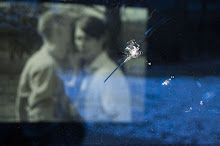I haven’t blogged since Palestine, but I have been thinking about it again, hoping to bring some blogging into my new venture, my forthcoming art and architecture practice Public Studio – so stay tuned. In the meantime, sitting here in the hospital with not much to do, I decided to take stock of my most recent adventures over the past week in the medical system, having experienced a mysterious pain in my abdomen last week. I apologize for the lack of visuals, I usually like to include more.
It all started on October 23rd, when, having just come home from a funeral I had a full bladder and went to relieve myself. Elle had taken Walter (1) downstairs to do the same, and by the time she came back upstairs, she found me in the bedroom on all fours unable to move and barely speak. Our family prides itself on our high pain thresholds – it is a Menno thing for sure (2)– so when I described it as ‘agony’, Elle knew she needed to get me to the hospital. We decided on St. Joe’s, simply because it was the closest, and in retrospect, it may have been worth a little more suffering to go further afield.
St. Joseph’s has a bad rap, and if you add the weekend factor, it pretty much lived up to its reputation as I viewed the stream of cops and handcuffed patients from my stretcher. I was shunted from emergency doctor to emergency doctor, from one misdiagnosis to another, finally being sent home with a catheter and little understanding about what had just happened to me. Admittedly, it was a tough case and seemed to stump everyone including my gynecologist who performed a laparoscopy on me 3 weeks ago, my family doctor, and the other physicians in my life: my sister, and one of my best friends, Leah. We had consulted with Leah throughout the weekend, forcing the doctors at St. Joseph’s to talk to her on the phone, as she seemed to always be one step ahead of them. Funny how doctors don’t like when you ask them to consult with your doctor friend - or your lawyer friends for that matter….
Yet for every cold and incompetent nurse (3) there is a warm and über-competent one, and for every dense and arrogant doctor, a thoughtful gifted one. I can’t say my hospital stay was completely miserable, for I realized that I was in a moment of complete dependence, and small communities based on time and space began to form around me, completely out of my control. As my stretcher moved from hallway to room, from room to room and back shuttled by those who knew me and didn’t, parked next to strangers, I started forming relationships with those around me, even if they were only for a few hours.
How else could we have met Pauline, the 89 year-old who needed Pam to lift her up in bed? Of course Pam (supportive friend and babysitter of Walter) did more than lift her physically, she lifted her spirits as well. In the course of their conversation, Pauline, who was a once a great beauty, discovered that Pam was Jewish and a woman, both to her disappointment. Yet they seemed to work it out, as Pauline wasn’t about to turn down her attentions. Things improved between Pam and the geriatric set at Mount Sinai (4) where she met Florence, the 94 year-old who needed some advocacy. Poor Florence (who seemed to have no issues with Jews) had been sitting in the hallway out with the rest of us and couldn’t even reach her meds that were dumped on her stretcher until Pam came to the rescue. I didn’t mind that Pam gave her my magazines and chocolate chip cookies, or lobbied hard for Florence, but I was certainly relieved that Pam decided to let loose into the nurses once I was well out of that animal house of an emergency ward and into my corner suite up on the urology ward.
But anyway, back to all of my ailments. I was hoping this would be a tale in retrospect but it seems I am yet undiagnosed. In a very un-Mennonite exposé, rather than go through the tedious tale of my ‘healing journey’ (5) I have compiled some statistics to date over the past 8 days:
2 hospitals
2 doctors offices
13 doctors
12 nurses
6 porters
14 bags of IV
4 doses of morphine
4 doses of Gravol
2 doses of Dilaudid (whoa……!)
2 doses Stemitol
14 blood collections
3 urine samples
5 doses Cipro
5 doses Keflex
1 laxative
6 abdominal exams
3 ultrasounds (2 internal)
2 CT scans (that’s a lot of radiation!)
4 catheters
1 cystoscopy (camera in ureter)
1 intravenous Pyelogram (X-rays of bladder filled with dye)
1 Paracentesis (siphoning off of abdominal fluid with needle)
My nurse Julie called me a model patient today: I never press the call button, I never ask for pain medication and I never complain. That would also make me a model Mennonite, but for the fact that I have just divulged every bit of medical information online to pretty much everyone I know.
Footnotes
1. our new Pooch – see picture.
2. For example, when we brought my mother into the emergency ward in Kenora this summer after she suffered a stroke at the cottage on the island, my sister (the doctor) described it to the nurse as ‘a mini-stroke but she seems to have fully recovered’. Even my brother who is also a stoic thought it a bit much!
3. The chart-topper being Lorna, the night-nurse who told me as a 41-year old woman I shouldn’t send my friends out to do my bidding (as I lay moaning) but press the call button. She was sitting at her station about 4 feet from my bed.
4. After being sent home from St. Joseph’s with a catheter which was subsequently removed, I began to feel a different sort of pain in my abdomen, more of the bloated tender type, and ended up going to Mount Sinai Saturday morning.
5. In the words of our friend Javan.
Tuesday, November 2, 2010
Wednesday, April 15, 2009
Unfortunately, it was Paradise*
Huda has five children; her four daughters live in the US and her son lives in England. Her husband died a few years ago and she often complains that she is lonely (1). She even has an American passport so we asked her, “Why don’t you go live in the States with your daughters, Huda?” She just says, “It is better here”.
As you may imagine, not everyone here holds that opinion. Living under occupation is no picnic, especially if you would like to choose where you live or if you want to go away for the weekend. Of course she was upset when she was denied her permit to go to visit her cousin over Christmas, but otherwise only travels when there is some orthodox saint that needs celebrating somewhere. She has a pretty long term view of this Occupation and lists this time in the history of Palestine as simply the most recent in a long line of Occupiers: “….the Ottomans, the British, and now the Isra-eelis.” Unlike our young Arabic teacher who burst into tears and flung herself on our sofa when Elle confessed she was Jewish (2), Huda doesn’t harbour the same feelings toward ‘the Yehud’. We will be watching Al Jazeera and there will inevitably be some story about Palestinian hardship at the hands of the IDF (3) but Huda will just shake her head as though they are naughty schoolboys: “Oh, those Isra-eelis……tsk tsk….more tea?” Don’t get me wrong, she is under no illusions about the situation here, but she doesn’t want to ‘throw them all into the sea’ as some have suggested.
I think the real reason Huda doesn’t leave though, is the produce. We thought the fruits and vegetables were fantastic in Israel but the markets in Tel Aviv and Jerusalem seem Canadian compared to the market here in Ramallah. Even so, Huda is very picky and doesn’t fill her cart with just any old tomatoes. Elle and I used to go to the market ourselves but after going with Huda, we feel completely unqualified to manage this on our own. “NO!” she said as I headed toward the baker who was pulling fresh pita out of the oven, “Not him!” I pick up a potatoe and look for her approval. She shakes her head and pulls me along. Looking for onions, she rummages through the pile, tossing aside the majority for the ones with the tops still intact. In this case, I can understand her criteria but for the most part I have no idea. “How does she do it?” we ask ourselves when we have bought some pears on our own but they turn out to be hard and flavourless.
Well the first rule is to buy in season, something we should already know, but here, anything in season is pure gold. When we arrived in Fall it was pomegranate season and we couldn’t get enough of them. Then ‘calamantina’ (4) arrived in December from Jenin or Gaza and the baby eggplants and squashes. In February it was the season of organic cauliflower from Halil(5) but you had to get the bright yellow ones that came from the village. Now we are addicted to the thick-skinned grapefruits from Jericho which are a cross between a pomelo and a grapefruit, sweet and delicious but seemingly only available by the bushel, which means we probably have enough to bring some home with us in June.
The other factor is that Huda is definitely connected to the right people. Lately, every time we walk into her kitchen, we see yet another pile of goat cheese on her counter, the flat white blocks stacked neatly in a pyramid. “More cheese, Huda?!!!”, we ask. “No, this is for my niece Rula”. If she was more enterprising, she would make a good wage as she works hard as a cheese dealer, packaging up her stash and calling for the re-up (6). The other day while we were hiking we stopped at a Bedouin village where the family had goats and was making fresh cheese. It was all very idyllic in an ethnographic kind of way, and while everyone was fawning over all of the dairy products they were making, we knew that Huda’s Bedouins were probably better.
She doesn’t do it for money though; she does it out of love, love for her family and friends, but also the love of food. She has a bit of an obsession with it, but not the stuff-your-face kind, the cooking and feeding others process. And it is this sixth sense she has cultivated over years of being obsessed with making everything as tasty as possible which has enabled her to pick the right cucumbers every time. As obsessions and addictions go, it is not a bad one, especially for anyone living vaguely close to her.
“Come’” she said, “after lunch we eat oranges in the sun”. We follow obediently to her front porch and sit beside the geraniums as she peels one for each of us. I try to imagine Huda at the Costco in Washington somewhere, wheeling some oversized cart around, frustrated that she can’t pick through the apples. “Better to stay here in my house”, she says, and I believe her.
*A collection of selected poems by Mahmoud Darwish
Footnotes
1. Huda complains about being alone but the truth is, she is actually rarely alone and has many visitors.
2. It was, as we say, a Woody Allen moment. As I looked over at Elle her sidelocks unfurled….
3. Israeli Defence Forces
4. Clementines
5. Hebron
6. If you have watched ‘The Wire’ you get it, if not, you should watch ‘The Wire’ any way, it is really good.
As you may imagine, not everyone here holds that opinion. Living under occupation is no picnic, especially if you would like to choose where you live or if you want to go away for the weekend. Of course she was upset when she was denied her permit to go to visit her cousin over Christmas, but otherwise only travels when there is some orthodox saint that needs celebrating somewhere. She has a pretty long term view of this Occupation and lists this time in the history of Palestine as simply the most recent in a long line of Occupiers: “….the Ottomans, the British, and now the Isra-eelis.” Unlike our young Arabic teacher who burst into tears and flung herself on our sofa when Elle confessed she was Jewish (2), Huda doesn’t harbour the same feelings toward ‘the Yehud’. We will be watching Al Jazeera and there will inevitably be some story about Palestinian hardship at the hands of the IDF (3) but Huda will just shake her head as though they are naughty schoolboys: “Oh, those Isra-eelis……tsk tsk….more tea?” Don’t get me wrong, she is under no illusions about the situation here, but she doesn’t want to ‘throw them all into the sea’ as some have suggested.
I think the real reason Huda doesn’t leave though, is the produce. We thought the fruits and vegetables were fantastic in Israel but the markets in Tel Aviv and Jerusalem seem Canadian compared to the market here in Ramallah. Even so, Huda is very picky and doesn’t fill her cart with just any old tomatoes. Elle and I used to go to the market ourselves but after going with Huda, we feel completely unqualified to manage this on our own. “NO!” she said as I headed toward the baker who was pulling fresh pita out of the oven, “Not him!” I pick up a potatoe and look for her approval. She shakes her head and pulls me along. Looking for onions, she rummages through the pile, tossing aside the majority for the ones with the tops still intact. In this case, I can understand her criteria but for the most part I have no idea. “How does she do it?” we ask ourselves when we have bought some pears on our own but they turn out to be hard and flavourless.
Well the first rule is to buy in season, something we should already know, but here, anything in season is pure gold. When we arrived in Fall it was pomegranate season and we couldn’t get enough of them. Then ‘calamantina’ (4) arrived in December from Jenin or Gaza and the baby eggplants and squashes. In February it was the season of organic cauliflower from Halil(5) but you had to get the bright yellow ones that came from the village. Now we are addicted to the thick-skinned grapefruits from Jericho which are a cross between a pomelo and a grapefruit, sweet and delicious but seemingly only available by the bushel, which means we probably have enough to bring some home with us in June.
The other factor is that Huda is definitely connected to the right people. Lately, every time we walk into her kitchen, we see yet another pile of goat cheese on her counter, the flat white blocks stacked neatly in a pyramid. “More cheese, Huda?!!!”, we ask. “No, this is for my niece Rula”. If she was more enterprising, she would make a good wage as she works hard as a cheese dealer, packaging up her stash and calling for the re-up (6). The other day while we were hiking we stopped at a Bedouin village where the family had goats and was making fresh cheese. It was all very idyllic in an ethnographic kind of way, and while everyone was fawning over all of the dairy products they were making, we knew that Huda’s Bedouins were probably better.
She doesn’t do it for money though; she does it out of love, love for her family and friends, but also the love of food. She has a bit of an obsession with it, but not the stuff-your-face kind, the cooking and feeding others process. And it is this sixth sense she has cultivated over years of being obsessed with making everything as tasty as possible which has enabled her to pick the right cucumbers every time. As obsessions and addictions go, it is not a bad one, especially for anyone living vaguely close to her.
“Come’” she said, “after lunch we eat oranges in the sun”. We follow obediently to her front porch and sit beside the geraniums as she peels one for each of us. I try to imagine Huda at the Costco in Washington somewhere, wheeling some oversized cart around, frustrated that she can’t pick through the apples. “Better to stay here in my house”, she says, and I believe her.
*A collection of selected poems by Mahmoud Darwish
Footnotes
1. Huda complains about being alone but the truth is, she is actually rarely alone and has many visitors.
2. It was, as we say, a Woody Allen moment. As I looked over at Elle her sidelocks unfurled….
3. Israeli Defence Forces
4. Clementines
5. Hebron
6. If you have watched ‘The Wire’ you get it, if not, you should watch ‘The Wire’ any way, it is really good.
Sunday, March 29, 2009
On the Road
We are working on a film about the roads here in Palestine (1) which takes us on many adventures as we drive around the West Bank with our camera pointed through the windshield. Sometimes the two of us just drive to see where we will get to and what we will find along the way. Other times we take along guides or passengers in exchange for their stories or comments on the drive. Most recently:
Ramallah to Jenin: We take our friend Sonia and her 13 year old son Qays to visit her elderly mother in Jenin. We go by taxi because we are not sure whether we can take our car with yellow plates into Jenin(2). We pass through approximately 4 checkpoints on the way, our driver nervously telling us to please put our camera away at the checkpoints. It is spring and the almond blossoms are blooming. Sonia is feeling nostalgic and narrates the journey for us, alternating between romantic tales of the past and resentment towards the Israeli presence felt everywhere. We decide to stay overnight with them, and walk around Jenin in the evening noticing everyone noticing us, a little surprised at the abundance of martyr banners on the lampposts.
Ramallah to Beit Ijza: Our 19-year old Arabic teacher Rand is very anxious to assist us. We tell her what we are working on and she asks whether we will take her on one of our drives, so we do. We have seen an image of a particularly brutal section of a road that is enclosed on either side by two massive walls, funneling Palestinians past settlements to outlying villages. Our neighbour Kleemans tells us this road leads to a home which is physically surrounded by a settlement. We find the road, the wall and the home embedded in the settlement. It is all a bit too much for Rand, who alternates between astonishment and crying. The man who lives in his home surrounded by the settlement is enclosed by a 20-foot high fence with barbed wire on top. I imagine the shape of his property in plan which must look like a lollipop, the driveway being the stick.
Ramallah to Nablus: We have adopted a baby lesbian here in Ramallah who has found a girlfriend from Nablus on the internet. Besides us, A and M don’t know any other lesbians in Palestine, which is probably why they got together. We have become a conduit for this budding romance, and decide to chaperone A to Nablus to see her girl, not asking her what web of lies we may be implicated in. We drive to Nablus in our car hoping to interview A along the way, but the interview is useless as she is not much of a talker, and probably more interested in her upcoming date, than indulge our questions on the road system. We ask her what she hopes for Palestine and she mumbles something about peace as she stares out the window. At the checkpoint we are not allowed in to Nablus so we leave our car and take a taxi into town. Despite being a new romance, A and M seem very familiar with each other and have an interactive style somewhere between flirtation and bickering. Unlike straight young love in Nablus, A and M can walk the streets together freely without scandal (lesbians don’t exist of course!). After lunch with Mom, we leave the two alone (that is, with her three brothers and mother) and head back home to Ramallah photographing the roads on the way.
Jerusalem to Hebron: We ask Ezra to take us on a tour of southern Palestine as this is his turf. We start in Jerusalem and head down south, weaving our way through Palestinian towns, Bedouin camps and settlements taking a combination of Palestinian roads and settler bypass roads. He wanted to show us the situation in Hebron, so we drove in the particularly nasty way, through Kiryat Arba, the settlement side of town which has been encroaching on the old part of Hebron. We soon found ourselves in the midst of checkpoint, army and settler hell. We were doing pretty well touring the insanity, until we got pulled over and ‘detained’. The army took our passports and two potty-mouthed settlers gathered round, filming us sitting in our car for some reason. They seemed to know Ezra already and had some odd insults regarding his manhood, contrasting their proliferation of children to his preference for houseplants. Ezra was so experienced in this charade he simply waited until our passports were returned and we drove back to Jerusalem to have dinner. I think we broke a record for how many checkpoints we passed that day. I don’t even remember.
Ramallah to Jericho: We had filmed the road to Jericho before, an old road recently refurbished for Palestinians as they are cutting them off from the No.1 highway which connects Jerusalem to the Jordan valley. This time however, we walked. We went with a hiking group from Ramallah which gets up at 6am most Fridays and heads to the hills exploring various trails and paths around Ramallah. We were a little worried after the taxi dropped us off near a remote village and the leader pulled out an inkjet print of a Google earth ‘map’ with our path sketched in blue marker between large mountains (3). Yet we were new to the group and put our faith in these seasoned hikers who must know where they are going. After about 3 hours of walking through valleys, across cliffs and down rocky ledges we were told that we didn’t exactly know where we were and, that we weren’t going to stop for breakfast yet. The good news was that there was really only one path, which was through the wadi (4) until it emerged on the eastern side of the range, hopefully near some form of transportation. The bad news was that elle’s knee gave out, so ‘hiking’ became more like ‘hobbling’ (accompanied with a side dish of serious kvetching). Well, in the end with the help of local shepherds, we emerged near a Bedouin village where we caught a taxi back to Jericho and then another back to Ramallah. In the cab on the way home, we chatted with a woman who pulled out her ID card at the checkpoint. Under nationality it stated: ****** (5). She had the blue ID, a Jerusalem ID as it was called, but no official identity.
Was she lost? No way, she knew exactly what side of the road she lived on.
Footnotes
1) Known as the ‘apartheid’ road system as most roads are segregated (between Jewish settlers and Palestinians) and controlled through a matrix of checkpoints and military towers.
2) Our rental car is Israeli and has yellow plates as opposed to the green Palestinian ones. Certain areas of Area ‘A’ do not allow Israeli cars (although Ramallah seems to be an exception).
3) We have a set of amazing Israeli hiking maps charting every square inch of Palestine, which would have been very helpful, but we kept that to ourselves….
4) Riverbed
5) That’s not an expletive: ****** is truly what it says next to “nationality”!
Ramallah to Jenin: We take our friend Sonia and her 13 year old son Qays to visit her elderly mother in Jenin. We go by taxi because we are not sure whether we can take our car with yellow plates into Jenin(2). We pass through approximately 4 checkpoints on the way, our driver nervously telling us to please put our camera away at the checkpoints. It is spring and the almond blossoms are blooming. Sonia is feeling nostalgic and narrates the journey for us, alternating between romantic tales of the past and resentment towards the Israeli presence felt everywhere. We decide to stay overnight with them, and walk around Jenin in the evening noticing everyone noticing us, a little surprised at the abundance of martyr banners on the lampposts.
Ramallah to Beit Ijza: Our 19-year old Arabic teacher Rand is very anxious to assist us. We tell her what we are working on and she asks whether we will take her on one of our drives, so we do. We have seen an image of a particularly brutal section of a road that is enclosed on either side by two massive walls, funneling Palestinians past settlements to outlying villages. Our neighbour Kleemans tells us this road leads to a home which is physically surrounded by a settlement. We find the road, the wall and the home embedded in the settlement. It is all a bit too much for Rand, who alternates between astonishment and crying. The man who lives in his home surrounded by the settlement is enclosed by a 20-foot high fence with barbed wire on top. I imagine the shape of his property in plan which must look like a lollipop, the driveway being the stick.
Ramallah to Nablus: We have adopted a baby lesbian here in Ramallah who has found a girlfriend from Nablus on the internet. Besides us, A and M don’t know any other lesbians in Palestine, which is probably why they got together. We have become a conduit for this budding romance, and decide to chaperone A to Nablus to see her girl, not asking her what web of lies we may be implicated in. We drive to Nablus in our car hoping to interview A along the way, but the interview is useless as she is not much of a talker, and probably more interested in her upcoming date, than indulge our questions on the road system. We ask her what she hopes for Palestine and she mumbles something about peace as she stares out the window. At the checkpoint we are not allowed in to Nablus so we leave our car and take a taxi into town. Despite being a new romance, A and M seem very familiar with each other and have an interactive style somewhere between flirtation and bickering. Unlike straight young love in Nablus, A and M can walk the streets together freely without scandal (lesbians don’t exist of course!). After lunch with Mom, we leave the two alone (that is, with her three brothers and mother) and head back home to Ramallah photographing the roads on the way.
Jerusalem to Hebron: We ask Ezra to take us on a tour of southern Palestine as this is his turf. We start in Jerusalem and head down south, weaving our way through Palestinian towns, Bedouin camps and settlements taking a combination of Palestinian roads and settler bypass roads. He wanted to show us the situation in Hebron, so we drove in the particularly nasty way, through Kiryat Arba, the settlement side of town which has been encroaching on the old part of Hebron. We soon found ourselves in the midst of checkpoint, army and settler hell. We were doing pretty well touring the insanity, until we got pulled over and ‘detained’. The army took our passports and two potty-mouthed settlers gathered round, filming us sitting in our car for some reason. They seemed to know Ezra already and had some odd insults regarding his manhood, contrasting their proliferation of children to his preference for houseplants. Ezra was so experienced in this charade he simply waited until our passports were returned and we drove back to Jerusalem to have dinner. I think we broke a record for how many checkpoints we passed that day. I don’t even remember.
Ramallah to Jericho: We had filmed the road to Jericho before, an old road recently refurbished for Palestinians as they are cutting them off from the No.1 highway which connects Jerusalem to the Jordan valley. This time however, we walked. We went with a hiking group from Ramallah which gets up at 6am most Fridays and heads to the hills exploring various trails and paths around Ramallah. We were a little worried after the taxi dropped us off near a remote village and the leader pulled out an inkjet print of a Google earth ‘map’ with our path sketched in blue marker between large mountains (3). Yet we were new to the group and put our faith in these seasoned hikers who must know where they are going. After about 3 hours of walking through valleys, across cliffs and down rocky ledges we were told that we didn’t exactly know where we were and, that we weren’t going to stop for breakfast yet. The good news was that there was really only one path, which was through the wadi (4) until it emerged on the eastern side of the range, hopefully near some form of transportation. The bad news was that elle’s knee gave out, so ‘hiking’ became more like ‘hobbling’ (accompanied with a side dish of serious kvetching). Well, in the end with the help of local shepherds, we emerged near a Bedouin village where we caught a taxi back to Jericho and then another back to Ramallah. In the cab on the way home, we chatted with a woman who pulled out her ID card at the checkpoint. Under nationality it stated: ****** (5). She had the blue ID, a Jerusalem ID as it was called, but no official identity.
Was she lost? No way, she knew exactly what side of the road she lived on.
Footnotes
1) Known as the ‘apartheid’ road system as most roads are segregated (between Jewish settlers and Palestinians) and controlled through a matrix of checkpoints and military towers.
2) Our rental car is Israeli and has yellow plates as opposed to the green Palestinian ones. Certain areas of Area ‘A’ do not allow Israeli cars (although Ramallah seems to be an exception).
3) We have a set of amazing Israeli hiking maps charting every square inch of Palestine, which would have been very helpful, but we kept that to ourselves….
4) Riverbed
5) That’s not an expletive: ****** is truly what it says next to “nationality”!
Subscribe to:
Posts (Atom)









